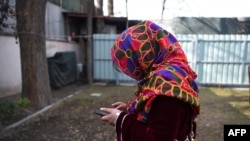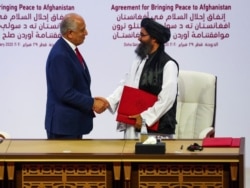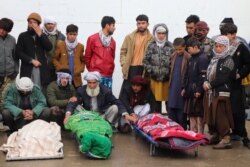Media advocates and international partners of Afghanistan have denounced the Taliban insurgency for threatening local journalists for allegedly not being impartial in their reporting of the country’s long war.
The warning coincided with allegations that the chief of the Afghan spy agency had also made a “constricting gesture” against the local media at a “confidential session” in Kabul with Afghan lawmakers.
On Thursday, unknown gunmen killed a former Afghan television anchor in southern Kandahar province. The slain man, identified as Naimat Rawan, was currently heading the media section at the Afghan Finance Ministry. No one took responsibility for the attack.
Rawan had only three weeks ago ended his contract with TOLO News channel, Afghanistan’s largest media network.
The renewed assault on Afghan media came as battlefield hostilities between government forces and the Taliban have spiked particularly since May 1, when the United States and NATO allies formally began pulling their troops out of Afghanistan after nearly 20 years.
Taliban spokesman Zabihullah Mujahid in a statement released via Twitter on Wednesday warned Afghan reporters to stop reporting and broadcasting what he alleged was “one-sided news at the behest of Kabul administration” or “face the consequences.”
A media advocacy group, Afghan Journalists Safety Committee (AJSC), swiftly condemned the insurgent threat.
It reminded the Taliban that they “must be committed to protecting the fundamental rights of citizens, of which freedom of expression is one example” under a February 2020 peace-building deal the Taliban negotiated with the United States.
AJSC also expressed concerns over recent remarks by the head of the Afghan intelligence agency, the National Directorate of Security (NDS), in which he slammed parts of local media outlets for allegedly broadcasting Taliban propaganda.
A lawmaker who attended the meeting quoted NDS chief Ahmad Zia Seraj as urging the media to be responsible and warning of legal action against those carrying “terrorist propaganda.”
“The fact that both sides involved in the conflict accuse the media of violating the principle of impartiality also shows that the media is not affiliated with any party and media do not bolster interests of a particular party,” stressed the AJSC statement.
The U.S. and British diplomatic missions in Kabul in a joint statement reiterated their strong support for Afghanistan’s independent media.
“We condemn in the strongest possible terms the ongoing violence and threats against the media, and the Taliban’s attempts to silence journalists,” tweeted Ross Wilson, the acting American ambassador.
(3/3) We strongly support Afghanistan’s independent media. We condemn in the strongest possible terms the on-going violence and threats against the media, and the Taliban’s attempts to silence journalists.
— Chargé d’Affaires Ross Wilson (@USAmbKabul) May 5, 2021
Afghanistan is considered one of the most dangerous countries in the world to be a journalist. Since 2006, as many as 76 journalists have been killed in Afghanistan, according to UNESCO.
Earlier this year, three female employees of a local broadcast agency in eastern Afghanistan were gunned down by Islamic State militants.
Afghan officials blame the Taliban for being behind most of the attacks on journalists in recent years. The insurgents reject the charges and accuse NDS operatives of carrying out assassinations of media workers as well as civil society activists as part of its campaign to malign the Taliban.
Critics have warned President Joe Biden’s decision to withdraw the remaining 2,500 U.S. troops from the country by September 11 would see more Afghan violence and bloodshed because it would encourage the Taliban to step up its military campaign to try to regain power.
Washington has recently increased diplomatic efforts to press the Taliban to reduce violence and negotiate a peace deal with the Afghan government. But the insurgents have halted the peace dialogue until all international forces leave Afghanistan.
The Taliban instead launched major battlefield attacks across the country in the last few days, overrunning district centers and government security outposts in several provinces.
The Taliban during Thursday’s fighting also seized control of the country’s second-biggest dam after months of fierce fighting in Kandahar. Afghan officials said the Dahla Dam provides drinking water for the region and irrigation to agricultural land via a network of canals.
Both Afghan adversaries have also claimed inflicting heavy casualties on the other, with civilians also getting caught in the crossfire while thousands of others are fleeing to safety.










